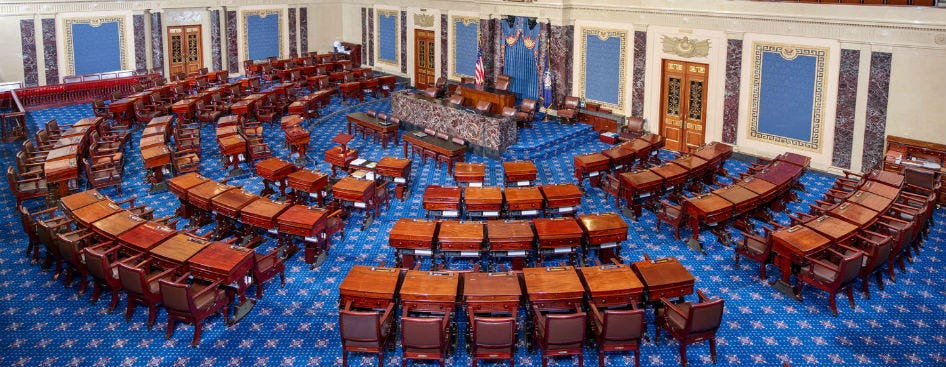A Halfhearted Eulogy for the Local Journalism Sustainability Act
Why a lack of federal aid to journalism until at least 2025 shouldn't be deeply mourned
Welcome to Second Rough Draft, a newsletter about journalism in our time, how it (especially its business) is evolving, and the challenges it faces.
With the passage of the Inflation Reduction Act under the Congress’s reconciliation process, that procedure is unavailable again until next year, and among the ideas left behind, very unlikely to see the light of legislative day until at least 2025— unless the Democrats retain the House as well as the Senate— is the Local Journalism Sustainability Act that once seemed on the verge of enactment. I come to this burial not to praise that proposal but to explain why the mourning for it should be limited.
The Local Journalism Sustainability Act came to comprise twelve pages of the 2000-plus page Build Back Better legislation, and would have offered a payroll tax break to subsidize local reporting. The subsidy was estimated at $1.7 billion, and, while most of it would have gone to benefit hedge fund owners of local newspapers and highly profitable TV stations1, many of the other recipients badly need the money and are doing critical work, so I held my peace while the bill wended its way through Congress.
Two cheers for content neutrality
Beyond this, the architects of the legislation, notably Steven Waldman, the co-founder of Report for America and soon to be the almost-full-time leader of a lobbying coalition Rebuild Local News, were very careful to craft a bill that is what is called “content neutral,” which means that the viewpoint of the publisher has no impact on whether or not they are eligible for funding. Such an approach dramatically limits the downside of such federal funding, and greatly constrains the risks of partisan interference. Waldman, who has made enormous contributions to journalism since even before authoring this important 2011 FCC report on the Information Needs of Communities, deserves great credit for the bill’s content neutrality.
As with many provisions of the Build Back Better omnibus, the Local Journalism Sustainability Act was a close run thing. There was a much more expansive proposal, which was trimmed back. Then the payroll tax fragment was in the bill, out of it, then back in. It was competing not only with some desire for fiscal discipline, but also with other priorities, many of them including the need to help those who are often voiceless. The version in the final iteration of Build Back Better rejected last year by Senators Manchin and Sinema was a smaller, time-limited piece of what had originally been envisioned by Rebuild Local News. The fragment almost made its way back into the Inflation Reduction Act which became law on Tuesday.
Along the way over the last 18 months, as supplicants for your federal tax dollars do, the potential aid recipients lobbied hard for the money. Some wrote op-eds and editorials, which is especially easy if you are a publisher of such things— and who can blame them? (Although I hope they might be more empathetic in future when it comes to “special interest” pleadings from others.) More recently, the lobbying was quieter, but still in earnest.
“Who can we lean on”?
In the earlier crunch, quite a few journalists were bragging on list servs and emails about the senators with whom they had snagged meetings or the representatives or staff members in their communities on whom they leaned personally. In the latest go-round similar efforts were presumably undertaken, even if more discreetly. All of that bothers and worries me, for a number of reasons.
First, most of this influence wielding was done out of public sight, where influence wielding is most often practiced. It’s something the press usually exposes, rather than participates in. Second, the members of Congress on the other side of these pleas are, how should we put, habitually transactional about such requests. How will the press avoid the temptation to think of those members who tried to help them as friends and those who didn’t as enemies, and, even worse, to have our readers eventually come to see it that way, and assume it is reflected in our coverage?
This last risk is greatly exacerbated by the fact that while the Local Journalism Sustainability Act had, at various times, as many as two dozen Republican House co-sponsors (although never any in the Senate), in the end whatever passed by way of reconciliation was always going to become law without a single Republican vote. So federal aid to journalism was at risk of becoming just another item on the laundry list of subjects that comprise our deep partisan divide.
Now, starting when Build Back Better began to fade and continuing to this day, the attention of those seeking taxpayer money for journalism shifts mostly to the states and localities. As we are seeing much more dramatically with abortion rights, consigning a national problem to state legislatures creates and exacerbates inequities, with the burdens falling hardest on those with the least power and the fewest resources— in this case, on smaller, poorer, more rural communities.
So I am not suggesting giving up on national projects to address the business problems of journalism, even as I strongly advocate for more community funding. I agree with advocates, in particular, that philanthropy, both institutional and among major individual donors, needs to do much more, and to recognize increasingly just how urgent the need is for funding public interest journalism as a public good. It’s just that I don’t think public money is the answer.
Local journalism needs cash. I have spent much of the last seven years trying to help address that problem, and will happily continue to do so. I know our businesses are in pain. But taking medication for pain carries risks, and sometimes those risks are greater than the pain they relieve. I hope we will, as an industry, be wary of this danger in the months and years ahead, and seek to build up and support new models of journalism that do not depend on tax dollars to succeed.
Gannett, which is now controlled by a hedge fund, was estimated to benefit by $37.5 million in lower federal taxes the first year alone. I don’t think even the bill‘s biggest fans expected them to restore that amount to the local news budgets for their papers.



Per your footnote, the act might have been content-neutral. It was NOT size-neutral or rather, it was not size-biased toward actual community papers, ie five-day dailies (print) and smaller. Why I was against it from the start. https://beloblogging.blogspot.com/2021/07/whats-to-stop-newspaper-owners-from.html
Not to defend hedge funds but the credits are tied to staffing, so owners would only benefit if they retain or hire journalists. The idea is to temporarily interrupt the downward trend, or stop the bleeding, while longer term solutions are pursued to restore and sustain local outlets.
If the credits were in place, Gannett would likely be laying off fewer or no reporters, because it could only receive a credit per journalist retained. The credits would also help local publishers buying the chains’ castoffs and starting new outlets.
Philanthropic support is great but see the latest from Medill on how it’s wildly uneven and mostly benefiting affluent and metro areas, not news deserts.